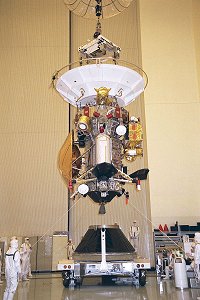|
Next up, I remember the Cassini probe, which
flew by Jupiter in the year 2000. The previous year, 1999
featured a solar eclipse that was visible from the UK; and
while my location wasn't best suited (in addition to there
being cloud), I looked out for it in our back garden. It was
during this time that I had a particular interest in
astronomy.
The Cassini-Huygens space-research mission
was to send the probe to study the Saturn and its system,
rings, and moons. It was named after Giovanni Cassini
(1625-1712) and Christiaan Huygens (1629-1695), who, while
being classed today as astronomers, were also astrologers.
The Huygens part was a lander which landed on Saturn's
largest moon, Titan.
Cassini was active in space for almost 20
years. The voyage to Saturn included two flybys of Venus, a
flyby of Earth, and a flyby of asteroid 2685 Masursky.
The Dragonfly mission is launch in 2027
(arriving in 2034) with a large nuclear-fuelled drone to fly
in the atmosphere of Titan.
|
|

The Cassini-Huygens assembly; this picture with the
people next to it provide a perspective on the size of
this thing. |